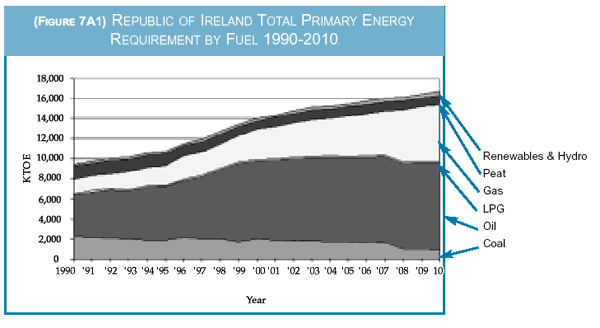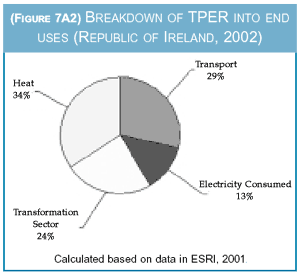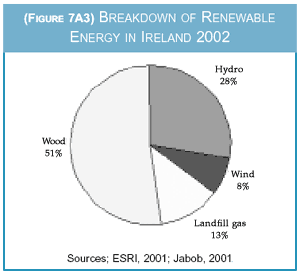
Two elements are crucial to the development of renewable energy
sources in Ireland - the quality of the resource and the quality of the
people involved in developing it. This article and those that follow it in
this section review both - and the obstacles the people face.
Renewables could meet a quarter of Ireland's
energy needs by 2010 but developing liquid
fuels for the transport sector will be a major
challenge.
Some energy sources are obviously better at
meeting particular energy needs than others.
This makes it necessary to examine the ways in
which Ireland uses energy and the trends in
those uses before the contribution that renewable
energy could potentially make to filling the
needs represented by those uses can be
assessed.
Figure 7A1 below shows the Total Primary
Energy Requirement (TPER) of the Republic of
Ireland, broken down by fuel type, over the
period 1990 to 2000 (ESRI, 2001). Estimates
for the period 2001 to 2010 are also included.
ENERGY TRENDS

The data is presented in units of kTOE (thousand tonnes of oil equivalent), where 1 kTOE is equal to 0.0419 PetaJoules (PJ). Analysis of Figure 7A1 shows the following key trends:
Figure 7A2 shows the sectors in which
the energy supply is used (for the year 2002).
 Energy is used in the heat, electricity generation
and transport sectors. Figure 7A2 shows both
the amount of energy actually used by consumers
in the form of electricity, and the
amount of energy lost in the transformation sector.
This transformation sector is primarily the
generation of electricity - only about one third
of the energy input to electricity generation is
delivered to consumers in the form of electricity.
Energy is lost as waste heat in power generation
and from electricity transmission and distribution
lines. It should also be pointed out that
there are losses in the heat and transport sectors
too - due to the inefficiencies involved in converting
heating fuel to thermal energy or transport
fuels to vehicular motion.
Energy is used in the heat, electricity generation
and transport sectors. Figure 7A2 shows both
the amount of energy actually used by consumers
in the form of electricity, and the
amount of energy lost in the transformation sector.
This transformation sector is primarily the
generation of electricity - only about one third
of the energy input to electricity generation is
delivered to consumers in the form of electricity.
Energy is lost as waste heat in power generation
and from electricity transmission and distribution
lines. It should also be pointed out that
there are losses in the heat and transport sectors
too - due to the inefficiencies involved in converting
heating fuel to thermal energy or transport
fuels to vehicular motion.
Renewables contributed about 1.8% of TPER in
2000 (250 kTOE out of a TPER of 13,591
kTOE; equivalent to 10.5 PetaJoules out of 569
PJ).  Figure 7A3 shows a breakdown of the different
renewable energy resources to the total
renewables contribution of 1.8%. The single
largest contribution is provided by wood (or
'biomass') - this is wood used to provide heat
in the domestic sector and in the wood processing
industry. Hydro electricity, electricity generation
from landfill gas and wind power were
the three other major renewable energy sources
contributing to energy supply in 2002. It should
be noted that the sources of geothermal, liquid
biofuels and solar thermal also provide some
supply but were not recorded in the sources
used to produce Figure 7A3.
Figure 7A3 shows a breakdown of the different
renewable energy resources to the total
renewables contribution of 1.8%. The single
largest contribution is provided by wood (or
'biomass') - this is wood used to provide heat
in the domestic sector and in the wood processing
industry. Hydro electricity, electricity generation
from landfill gas and wind power were
the three other major renewable energy sources
contributing to energy supply in 2002. It should
be noted that the sources of geothermal, liquid
biofuels and solar thermal also provide some
supply but were not recorded in the sources
used to produce Figure 7A3.
The projected energy demand in 2010 is 18,700 kTOE (see Figure 7A1). The Renewable Energy Information Office of Sustainable Energy Ireland (2002) estimate that "renewable energy sources could practicably supply a quarter of Ireland's energy requirements in 2010" (over 4,000 kTOE of renewables). Biomass, wave and wind in particular are considered to have significant potential for further development. It can be concluded therefore that a mix of renewable energy sources could make a major contribution to the energy supply of the Republic of Ireland in the near future. A particular challenge will be to develop transport fuels based on renewable resources - the transport sector is almost entirely dependent on oil. It is important that government policy and development efforts promote the required mix of renewable energy sources across the electricity, heat and transport sectors.
The conference which led to this book was notable not only for the range of national and international speakers on the programme, but also for the fact that it was supported by all the associations dealing with sustainable energy in the Republic of Ireland. These were the Association of Irish Energy Agencies; the Geothermal Association of Ireland; the Irish Bioenergy Association; the Irish Hydro Power Association; the Irish Solar Energy Association; the Irish Wind Energy Association; and Meitheal Na Gaoithe. Collectively, these organisations comprise a key resource in the development of renewable energy in Ireland, as the papers which follow show.
Thanks to Mr. Joc Sanders for production of Figure 1 while working on contract for Tipperary Institute.
ESRI, (2001). Energy Demand Projection Model. Economic and Social Research Institute. Dublin.
Jacob, J. (2001). Answer to Dáil Question No. 30, 20th June 2001. Minister of State in the Department of Public Enterprise. Dublin.
Sustainable Energy Ireland, (2002). Renewable Energy Research, Development & Demonstration Programme
- Programme Strategy, Dublin. Available from www.sei.ie
This is one of almost 50
chapters and articles in the 336-page large format book, Before the Wells
Run Dry. Copies of the book are available for £9.95 from Green Books. Continue to part B of Section 7: An overview of bioenergy in Ireland - potential and barriers
